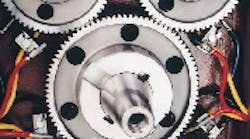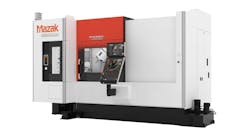To maintain an aggressive production schedule, a major aerospace company jettisons its in-house multispindle gearbox manufacturing operations.
Zagar's gearbox package for Boeing consists of a five-spindle, gear-driven head with quick-change adapter and pulse-mist lubrication system.
A Zagar multispindle head simultaneously mills four triangular pockets for a weight-reducing pattern in rocket skins.
Equipped with the Zagar head, a gantry-style profiler from Cincinnati Machine face mills a rocket skin. Cincinnati played an integral part in developing the multispindle head for Boeing.
If the market dictates, more rockets will shoot skyward in the next six years than during a Fourth of July fireworks display. The U.S. Air Force and private customers need vehicles to carry communications and positioning satellites into space. And this growing demand has forced Boeing to ramp up its Delta IV rocket program.
The company expects so much work that it built a new 1.5 million-ft 2 facility in Decatur, Ala., to manufacture the Delta IV. Inside the plant, Boeing has stocked up on some new machines that efficiently mill aluminum isogrid skins that form the fuel and oxidizer tanks for the common booster cores that make up the launch vehicle for each satellite. Skin sections vary in size, some measuring up to 10 40 ft, but all have the same weight-reducing machined pattern of repeating triangular pockets (isogrids). At its Huntington Beach, Calif., facility, Boeing cuts these on gantry-style mills equipped with multispindle gearbox heads it made in-house. But because of tightening production schedules, the company decided to develop a statement of work and outsource the heads for Decatur.
The new plant's five-spindle milling heads, made by Zagar Inc. of Cleveland, run at high rpm to reduce skin machining time. They also include monitoring devices for an aggressive Boeing preventative-maintenance program, quick-disconnects for simplified rebuilding operations, and innovative, programmable lubrication systems.
In Zagar's five-spindle setup, the main center spindle drives the others and connects to the machine tool's spindle via CAT #50 taper milling machine mount. The four corner, or orbital, spindles each have #63 HSK sockets for quick-change, high-velocity tooling that handles a cutting load up to a 25 hp. Rotating at 7,200 rpm, the center spindle (HSK 100) cranks the four orbital spindles up to 10,000 rpm.
The heads run on a single-spindle, three-axis, rail-type profiler from Cincinnati Machine, also a partner in the project. The host spindle delivers 100 continuous horsepower above 5,000 rpm and 125 horsepower (duty rated) above 7,000 rpm. Speeds range from 100 to 10,000 rpm.
Cincinnati designs and builds these gantry machines to customer specifications. The Boeing machines feature Acramatic 950 CNC and operate on 460/3/60 current. Work-mounting surfaces are 144-in. wide with rail lengths of 109.5 in. Spindle noses get as close as 5 in. from the work-mounting surface and as far away as 33 in. The X-axis rail lengths are 108 in.
Cincinnati's machine easily accommodates the rocket skins within its 70-in. X-axis, 164-in. Y-axis, and 28-in. Z-axis travels. Feedrates in the X and Y axes are 1 to 600 ipm and 1 to 100 ipm in the Z axis.
To machine a skin, aluminum plate is loaded on a vacuum chuck for facing operations. Boeing mounts a large standard face mill into the head's center spindle and cuts the part flat. Next, the face mill is removed and four cutters, each in an orbital spindle, simultaneously rough mill four pockets in a three-axis motion. The system uses a total of 100 hp during this roughing operation. Finally, finish cutters replace roughing tools to bring the pockets into specified wall and floor thicknesses. Boeing removes between 60% and 70% of the stock from a single skin panel.
Zagar, which designs and builds multispindle heads, feed units, workholding, and complete machine tools, designates three main components of the Boeing gearbox package. These are the gearbox itself, the pulse-mist lubrication system, and the precision quick-change mounting adapter.
Design changes
The Boeing Huntington Beach plant machines different rocket skins using multispindle gear boxes designed in the mid-seventies. Their speed is limited to 6,000 rpm, so Boeing asked Zagar to speed up the new ones to better handle increased production. Increasing spindle speed, says Randy Roberts, vice president of Zagar, involved refining gears, bearings, the gearbox casting, and bearing lubrication.
In a combined effort, Zagar and Cincinnati Machine incorporated ceramic hybrid bearings and established special clearance calculations to produce bearing packs that could deal with the increased speed. Besides its engineering expertise, Cincinnati also supplied machine time at its facility for testing Zagar's prototype heads.
"Basically," says Roberts, "we reset parameters for assembly, preload, and clearance of the heads' spindle cartridge packs." The four outside spindle heads all have individual, rigid bearing packs. The center spindle has only a bearing pack at the bottom of the head (near the base). Its upper pack is actually the drive spindle of the machine. What's also critical, adds Roberts, is that the bottom of the four spindle noses must be on a common plain within three-tenths and perpendicular within a thousandth of an inch.
Faster spindles also meant that Zagar had to develop a special head casting with chambers for flow-through coolant. "It helped that we knew what type of machines the heads would reside on," says Roberts. With this knowledge, Zagar designed its heads to tap into the Cincinnati machines' on-board chillers. These circulate a tempera-ture-controlled water/ glycol solution though the milling head and the machine's spindle drive motor.
The mounting surface of both the milling machine and the multispindle head must be parallel. This means that every time a new head is put on, technicians must shim it square. To eliminate time spent aligning heads, Zagar devised a mounting adapter that bolts to the milling machine's spindle mount.
Fitting spacers go between the adapter and the machine tool's spindle mount. Once the bottom adapter surface is perpendicular and concentric to the spindle center (to within five-tenths), the adapter is permanently attached. Any Zagar head then mounts to the adapter with a series of socket-head cap screws and a Jergens 50-mm ball-lock, quick-change system. The ball-lock system quickly and accurately locates the head. To rotate heads 90° for different milling operations, operators simply loosen, turn, and relock the head in its new position.
Maintenance
The multispindle heads in use at Huntington Beach have no preventative maintenance, says Robert Dumas, manager of NC programming at the facility. "They are serviced only when they fail — burn up a bearing or seize during operation. There is no way of noticing wear on the gearbox unless it is removed from the milling machine and taken apart for inspection. And maintaining the heads required extensive inventories of spare parts to keep them in operation. For these reasons, we specified the addition of an hour meter on every gearbox." With these meters, maintenance personnel can log hours to perform servicing on the gearboxes in timely intervals. In addition, Zagar-provided service manuals have helped Boeing establish its preventative maintenance program.
It takes approximately one day to remove a gearbox, up to a week or longer to repair, and two days to reinstall. The company says the Zagar heads are going to be more reliable than the in-house ones because of some added features.
Zagar incorporated thermo-coupled sensors that record heat spikes in bearings. The gantry machine's controls monitor these sensors and, in the event of excess heat, will shut down the system, a safeguard developed by Cincinnati.
Four locking bolts secure each head in place and allow for quick disconnection and removal of the upper housings. Boeing stocks only a small number of spare ceramic bearings and spindle sleeves for quick repairs.
In-house testing
The Zagar heads measure 24-in. in diameter and weigh 975 lb, so instead of sending them and the necessary personnel back and forth from Ohio to California., Zagar tests the heads in-house on a custom-built stand that duplicates all of the machine operations except cutting. Zagar technicians then monitor temperatures, test spindles, and conduct run-ins.
The test setup includes temperature monitors and an operating coolant system. The same coolant mixture run in the Cincinnati machines circulates through the head. A pulley-and-belt system slowly drives the head up to 10,000 rpm. "It's gradual," says Roberts, "the total run-in process takes 40 hours — 10 hours to attain 10,000 rpm, then another 30 hours running at that speed."
While the head is running, Zagar tracks not only all bearing temperatures but also those of the casting and coolant. A software program records all changes in temperature, and the heads' programmable lube system keeps bearings from running hotter than 125°. Pressure tests during the run-in ensure the coolant system is up to par. In addition, technicians check and record all critical dimensions on each spindle that relate to parallelism, perpendicularity, and T.I.R. before and after the run-in. This ensures that nothing has changed and provides Boeing with an accurate and detailed specification report on each head they receive.






